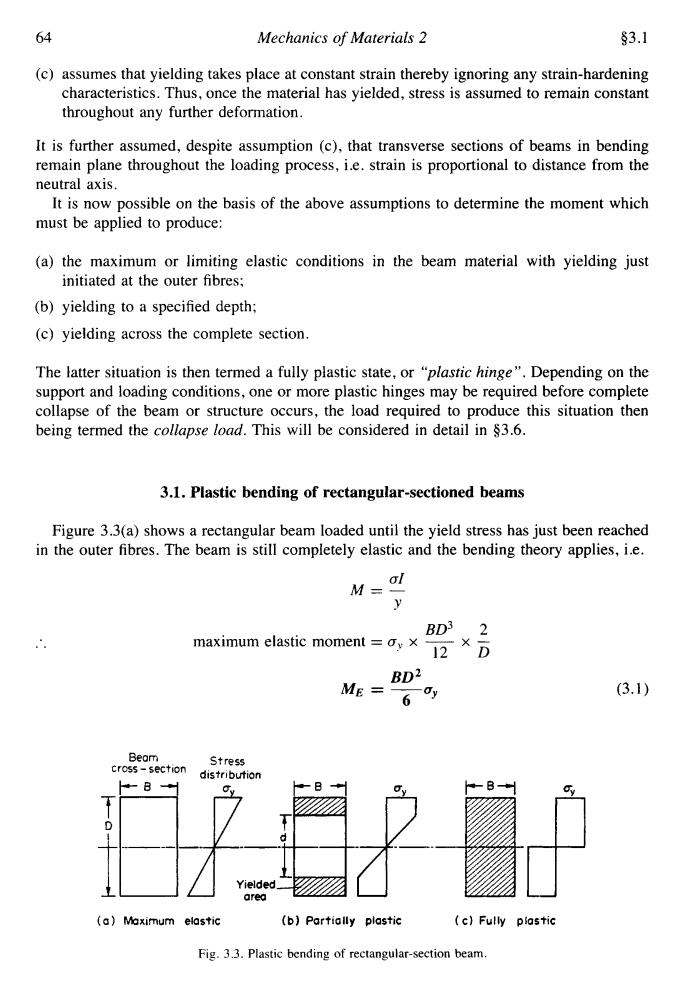正在加载图片...

64 Mechanics of Materials 2 $3.1 (c)assumes that yielding takes place at constant strain thereby ignoring any strain-hardening characteristics.Thus,once the material has yielded,stress is assumed to remain constant throughout any further deformation. It is further assumed,despite assumption (c),that transverse sections of beams in bending remain plane throughout the loading process,i.e.strain is proportional to distance from the neutral axis. It is now possible on the basis of the above assumptions to determine the moment which must be applied to produce: (a)the maximum or limiting elastic conditions in the beam material with yielding just initiated at the outer fibres; (b)yielding to a specified depth; (c)yielding across the complete section. The latter situation is then termed a fully plastic state,or "plastic hinge".Depending on the support and loading conditions,one or more plastic hinges may be required before complete collapse of the beam or structure occurs,the load required to produce this situation then being termed the collapse load.This will be considered in detail in $3.6. 3.1.Plastic bending of rectangular-sectioned beams Figure 3.3(a)shows a rectangular beam loaded until the yield stress has just been reached in the outer fibres.The beam is still completely elastic and the bending theory applies,i.e. σl M= y BD3 2 maximum elastic moment =o x 12* D BD2 ME= 6 (3.1) Beam cross-section Stress distribution 一B✉ 9 D Yielded_ area (a)Maximum elastic (b)Partially plastic (c)Fully piastic Fig.3.3.Plastic bending of rectangular-section beam.64 Mechanics of Materials 2 53.1 (c) assumes that yielding takes place at constant strain thereby ignoring any strain-hardening characteristics. Thus, once the material has yielded, stress is assumed to remain constant throughout any further deformation. It is further assumed, despite assumption (c), that transverse sections of beams in bending remain plane throughout the loading process, i.e. strain is proportional to distance from the neutral axis. It is now possible on the basis of the above assumptions to determine the moment which must be applied to produce: (a) the maximum or limiting elastic conditions in the beam material with yielding just (b) yielding to a specified depth; (c) yielding across the complete section. initiated at the outer fibres; The latter situation is then termed a fully plastic state, or “plastic hinge”. Depending on the support and loading conditions, one or more plastic hinges may be required before complete collapse of the beam or structure occurs, the load required to produce this situation then being termed the collapse load. This will be considered in detail in 53.6. 3.1. Plastic bending of rectangular-sectioned beams Figure 3.3(a) shows a rectangular beam loaded until the yield stress has just been reached in the outer fibres. The beam is still completely elastic and the bending theory applies, i.e. .. DI M=- Y BD3 2 maximum elastic moment = cry x - x - 12 D BD~ ME = - 6 uy Beam Stress Cross-section dis+,,bvtion (3.1) (a) Maximum elastic (b) Partially plastic (c) Fully plastic Fig. 3.3. Plastic bending of rectangular-section beam